Hall of Justice: stately ruin no more
October 2, 2014
After a $231-million renovation that spanned a decade, the Hall of Justice — site of Charles Manson’s trial and Marilyn Monroe’s autopsy — will be rededicated Wednesday as the new headquarters of the sheriff and district attorney.
The Beaux Arts landmark, built in 1925 and red-tagged in 1994 because of damage from the Northridge earthquake, has been transformed into a modern-day office building that celebrates its storied past.
“I am thrilled to see this architectural gem restored,” said District Attorney Jackie Lacey, who will move in around December or January. “Although it’s no longer a courthouse, it still will be a place where justice is served.”
Located on 211 W. Temple Street, the hall has been an integral part of Los Angeles’ history and downtown skyline for almost a century.
Designed by Allied Architects in the Italian Renaissance style, it was the first building in the nation to consolidate law enforcement facilities under one roof. The sheriff, district attorney, coroner, public defender and even tax collector have all, at one time or another, maintained operations there.
The 14-story, 550,000 sq. ft. high-rise also had 17 courthouses and 750 cramped jail cells that housed as many as 2,600 inmates at a time.
Aside from Charles Manson, the hall’s most notorious occupants were Sirhan Sirhan, who assassinated Senator Robert “Bobby” Kennedy; mobster Benjamin “Bugsy” Siegel, and “Nightstalker” serial killer Richard Ramirez.
Daredevil Evel Knievel staged a grand exit from the hall after serving time for assault. He ordered about 20 limousines to pick him up, along with every other inmate released on the same day.
The famous and infamous were not relegated only to the jail cells and courtrooms. Marilyn Monroe and Robert Kennedy’s remains were once examined on slabs in the autopsy suites.
When the Northridge earthquake struck in 1994, the hall itself almost became history. With rows and rows of jail cells with steel bars on the uppermost floors, the building was top heavy, so it twisted violently during the magnitude 6.7 temblor. The foundation survived unscathed but the interior walls were rendered unstable, potentially collapsing on people.
The Sheriff’s Department moved to leased offices in Monterey Park and the hall was left to molder until 2004, when the Board of Supervisors voted to authorize its renovation—as long as it was “cost-neutral”—at the urging of then-Sheriff Lee Baca.
LASD Facilities Director Gary Tse said Baca fervently believed the hall was the department’s rightful headquarters. Baca, Tse said, “wanted the department to ‘go home’ — that was how he phrased it.”
Baca, however, retired early this year amid scandals over brutality in the jails and the indictment of more than a dozen deputies. Now his successor, who’ll be elected Nov. 4, will be based at the hall.
County Chief Executive Officer William Fujioka calculated that the cost of issuing bonds for the renovation could be offset by savings from private leases that agencies would no longer have to pay after moving into the hall.
“The combined annual lease savings from the Sheriff, DA and CEO lease terminations total is $10 million,” he wrote in a report. “These saving will be applied toward the Hall of Justice financing payment costs.”
Contractors with AC Martin Partners and Clark Construction Group gutted the building and even sold the steel from the jail cells to a recycler for about $500,000.
They also merged a couple of floors to leave only 12 stories with 300,000 sq. ft. of usable space to be occupied by 1,600 workers from the Sheriff’s Department and District Attorney’s Office.
(AC Martin Partners’s website has architectural drawings of the hall’s interior design. Clark Construction’s website has photos of the demolition and renovation. Supervisor Zev Yaroslavsky’s website also checked in on the renovation’s progress, with this story and photo gallery. )
The seismic retrofit included reinforcing the building’s four corners with 1,000 tons of rebar, prompting Tse to say the hall is “now probably one of the safest buildings in L.A.” Workers also outfitted the building with state-of-the art mechanical, electrical, plumbing and data systems, and — for the first time — centralized heating and air-conditioning. They even built a bioswale into the landscape to collect and filter water seeping into the aquifer.
Architect Ryan Kristan, a consultant of the county Department of Public Works, was excited about using modern technology to revive an old building he remembers seeing in a black-and-white rerun of the television classic “I Love Lucy.”
“The demolition was loud and messy and very destructive, but once we started putting walls up and modern utilities in, the building felt like it was coming alive,” Kristan said. “And when we turned on the air-conditioning, it was as though the building was breathing again.”
Other new additions include a 1,000-space parking garage erected next to the hall, alongside the 101 Freeway, and a 12-foot-tall bronze statue of Lady Justice to be installed at the main plaza next month.
The county hired conservationists to make sure the renovation did not do away with “character defining” features that made the hall eligible for the National Register of Historic Places.
They restored the grand lobby to its former glory, complete with marble columns and gilded ceilings from which hung ornate chandeliers, each weighing about 700 lbs. They power-washed the facade’s Sierra white granite, which had turned a dirty gray, using water infused with miniscule glass beads. The stone now gleams like those at Los Angeles City Hall, built in 1928 — after all, they came from the same quarry. Also preserved were the terra cotta sculptures that embellished the granite. Most of the original windows, doorways with transoms and staircases with wrought iron balusters have also been retained.
“They don’t build buildings like this anymore,” Michael Samsing, who works in asset planning and strategy for the county CEO, said while admiring the antique elevator cabs, now attached to modern mechanisms with digital displays that transport occupants directly to the floor of their choice.
The cell block that once housed Manson and Sirhan has been preserved as part of an historical exhibit. It had to be taken apart piece by piece, and then painstakingly reassembled several floors below its original location.
County Department of Public Works senior capital project manager Zohreh Kabiri said renovating the hall is “way more complicated than starting a building from scratch,” but a great honor.
“The most enjoyable part is to preserve history and not see this building be demolished,” she said. “This is a historic landmark and being part of the team to restore it for future generations is something to be very proud of.”
Posted 10/2/14
Art is the next big thing
July 24, 2014
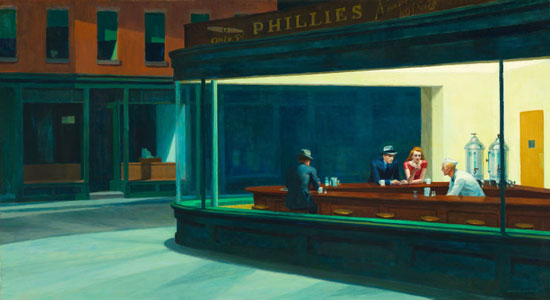
"Nighthawks," from the collection of the Art Institute of Chicago, will be seen in L.A. and nationwide.
Edward Hopper’s moody “Nighthawks” will be having their after-hours cups of java on a wall in San Francisco—and at 18 feet high by 50 feet wide, they’ll be hard to miss.
Grant Wood’s dour duo from “American Gothic” will be living large on the staircase of New York’s Port Authority.
And here in L.A., rush hour traffic will be getting a jolt of cultural uplift as buses rumble by wrapped in iconic works like Ed Ruscha’s “Hollywood.”
Just like millions of vacationers, American art is hitting the road this summer.
Starting August 4, 58 masterpieces will be breaking out of five major museums and onto the streets. The exhibition, called Art Everywhere US, is modeled after a similar show in the United Kingdom and is intended to create what the organizers call a “free, open-air art gallery across the country” throughout the month of August.
The featured reproductions include 11 pieces from the Los Angeles County Museum of Art. Among them: Andy Warhol’s “Campbell’s Soup Can,” Roy Lichtenstein’s “Cold Shoulder,” Willem de Kooning’s “Montauk Highway” and Mark Rothko’s “White Center.”
But L.A.’s al fresco gallery won’t be limited to the LACMA works; all 58 of the featured pieces will be on display here at some 500 locations around town. Exact locations will be announced soon on the project’s website, where an interactive map will make spotting the masterpieces easy. There also will be an Instagram contest for people to show off selfies they’ve taken with the oversized artworks.
In addition to the wrapped buses, “the digital billboards in L.A. will be featuring the art works,” said Stephen J. Freitas, chief marketing officer of the Outdoor Advertising Association of America, which is collaborating on the project with LACMA, the Art Institute of Chicago, the National Gallery, the Whitney and the Dallas Museum of Art. “We’ve got a wonderful Warhol that’s going to be coming your way on a lot of bus shelters.”
Nationwide, the art is being displayed in all 50 states on donated billboard and other advertising space valued at tens of millions of dollars, Freitas said. The effort started with 100 works of art suggested by the museums; members of the public then had a chance to vote on their favorites to winnow down the list to the final 58.
Taken together, the pieces represent a kind of American Art 101—from Gilbert Stuart’s portrait of George Washington to Robert Mapplethorpe’s portrait of “Ken Moody and Robert Sherman.”
“It’s a great opportunity not only for LACMA to represent Los Angeles, but to show its history through a painting like Millard Sheets’ ‘Angel’s Flight,’ or Ed Ruscha’s depiction of the Hollywood sign,” said Michael Govan, LACMA’s director and CEO.
And you don’t need to be an art history major to enjoy it.
“We’re hoping this campaign will help drive more interest in American art and drive people to more American museums to see art in person. But we also think it’s a great way to just give people a lift in their day, give them something unexpected on their way to work or traveling down the road,” Freitas said. “We think it will inspire a little happiness in American life, we hope, for a few days or a few moments.”
Posted 7/24/14
Green river milestone
July 10, 2014
Improving the Los Angeles River has become a local cause célèbre, with increasing numbers of Angelenos pushing to transform the concrete channel into a place where people can exercise, play and relax.
This Saturday, L.A. County takes a big step toward that goal when it opens the L.A. River Headwaters Project, which is located at the river’s official beginning—the convergence of Calabasas and Bell creeks in Canoga Park.
The $11.5 million project is the river’s largest greenway improvement so far, with 2.5 miles of upgrades that benefit the public and the environment. Cung Nguyen, the river’s watershed manager for the Department of Public Works, said the opening is an important milestone.
“If we improve the beginning and end of the river, then we can start filling in all the gaps,” Nguyen said. “Ultimately, the grand picture is to provide connectivity for recreation along the whole river.”
Joggers and bicyclists will gain access to 2.5 miles of new trails (1¼-mile in each direction) on which to ride and run, passing safely under street crossings and over pedestrian bridges. Rest areas with benches will provide pit stops for those who prefer to take a slower pace.
Native landscaping replaces the former backdrop of an access road and chain link fencing. It also creates new habitat for wildlife, including 300 species of migratory birds that rest their wings by the river. Maintenance crews have been trained to know when nesting seasons are so they won’t disturb the avian guests as they pass through.
The project is still designed to help prevent devastating floods while reducing the amount of urban runoff with bioswales—subsurface plant and sediment-filled structures that let water seep into the ground to be filtered naturally rather than getting fast-tracked, pollutants and all, into the ocean. Nguyen estimated that up to 587,000 gallons of water will be recaptured in an average year.
The headwaters project is funded by the county Flood Control District, along with a $1.8 million grant from Prop. 84, a state initiative dedicated to improving water systems. The project originated with the 1996 L.A. River Master Plan, which recognized the waterway’s importance as a natural resource and targeted publicly-owned lands for future projects. More than 50 of those projects have been completed to date, with another 50 or so to come. Coming up are more greenways like the headwaters project as well as things like wetlands, parks, bike paths and kayaking programs. Just last month, another San Fernando Valley greenway, the half-mile Valleyheart Riverwalk project, opened between Studio City and Sherman Oaks.
While those project-by-project efforts continue, a $1 billion revitalization plan approved by the Army Corps of Engineers in May is expected to drastically improve a sweeping 11-mile section of the river between downtown L.A. and Elysian Park.
But every piece matters; even after the entire river is revitalized, few people will use all 51 miles of it in a single day. The local community of Canoga Park stands to benefit most from the headwaters project, something that Luis Rodriguez, principal of Canoga Park High School, is keenly aware of. His school sits just west of the headwaters. He sees a great educational opportunity for his students, who have been focusing on topics like water conservation and drought-resistant plants in the context of one of California’s most severe water shortages on record.
“For our school it makes a huge difference, but it’s going to revamp the entire community in a positive way,” Rodriguez said. “There’s so much industry in our area, but living spaces where people can have fun? That’s something that is really needed.”
The official opening ceremony takes place at 11 a.m. on Saturday, July 12, at DeSoto Avenue and the Los Angeles River in Canoga Park, 91303.
Posted 7/10/14
Metro’s bicycle brain trust
February 25, 2014
There was once a time, not long ago, when bicyclists weren’t much more than a squeaky wheel to Metro—and not in a good way.
What a difference four years makes.
On February 19, 2010, the cycling community got a seat at the transit table when Metro hosted its first Bicycle Roundtable meeting.
It was the beginning of an important collaboration—one that would lead to some major improvements for cyclists within the Metro system. But you wouldn’t have known it from the rocky start of the process, as cyclists started engaging warily with a government agency that hadn’t always been so welcoming.
“They distrusted us and were very assertive about issues we needed to address and policies we needed to embrace,” said Diego Cardoso, Metro’s executive officer in charge of the bicycle and pedestrian program. “Those were the days when Metro was transitioning as an agency in terms of mobility and bicycling in L.A. County.”
Intended as a forum for bike advocates to exchange ideas with the transit agency, the meetings grew out of a rising tide of vocal cycling activism. “The bicycle community was demanding in terms of getting Metro, cities and the county to deal with issues of how to improve mobility for bicycles,” Cardoso said. “We said ‘Well, let’s bring them together.’ ”
Though contentious at first, the discussions soon evolved in ways that have helped shape the emergence of cycling as a major mode of transportation in the county.
One of the earliest results was the end of a ban that kept bikes off trains during peak periods of travel. What’s more, the agency has even removed seats from rail cars to clear more room for cyclists to bring their rides aboard. And Metro has more than doubled the share that bicycles get in its competitive Call for Projects program, which funds local initiatives with regional significance. (Cycling programs now get 15% of the pot, which in the last cycle totaled $199.4 million.)
The collaboration also has led to new public education programs promoting safety. The highly visible “Every Lane is a Bike Lane” campaign grew out of roundtable discussions, and last summer, Metro launched bicycle safety classes taught by advocacy groups that attend the meetings.
On the political side of things, Metro’s Board of Directors has provided support as well, officially recognizing bicycling as an official “mode of transportation,” putting it on equal footing with motorized travel.
Next up: bike-sharing.
“Bike share is a good example where they basically asked ‘What do you think?’” said Eric Bruins, director of policy and planning for the L.A. County Bicycle Coalition. “Feedback from the roundtable was very clear—there should be one regional vendor and we want to see a strong leadership role from Metro.”
The agency, spurred by a motion by Mayor Eric Garcetti, Supervisor Zev Yaroslavsky and others, stepped in after the city of L.A.’s bike share program foundered and took the lead in creating a county-wide bike sharing plan. In December, Metro’s board expanded the agency’s role, directing it to fund the plan by teaming up with local jurisdictions.
An update on the bike share project’s progress—including input from the roundtable group—is scheduled to come before Metro’s board in April. According to Cardoso, the agency is in the process of contracting with an outside company to help implement the program, with Los Angeles, Santa Monica and Pasadena serving as pilot cities.
Another upcoming project aims to build five new “bike hubs,” structures that will offer secure parking, repairs and other resources, at major public transportation hotspots. The first one, at El Monte Station, will open later this year. Other hubs are planned for Union Station, Culver City Expo Line Station and two Red Line stations—Hollywood/Vine and North Hollywood.
The roundtable’s most recent meeting earlier this month drew a mix of cycling aficionados, staff from government agencies and the offices of elected officials and even a couple of unaffiliated members of the public. Attendees came from all over: Santa Monica, Montebello, even Orange County.
One regular participant, Dennis Hindman, 61, of Toluca Lake, said he’d like to see more folks from the public take part in helping the agency get more of a grassroots perspective. “It gives you the insight of actual experience,” he said. “You may have missed something from a practical standpoint that just won’t work in real life.”
Miguel Ramos, a volunteer for Multicultural Communities for Mobility, was attending for the first time. Ramos’ mission is to promote inclusion of all of the region’s diverse communities in bicycle projects—something he said is simply “not happening in low income communities” nationwide.
“These communities already have a growing bicycle culture,” Ramos said. “It’s about recognizing that fact and allowing their voices to be heard.” To achieve that, he said, Metro must increase outreach in multiple languages.
For his part, Bruins of the Bicycle Coalition said he would like to see a higher level of participation by a broader range of Metro staffers.
“Metro has many departments,” Bruins said. “We’d like to see other departments come to the bike roundtable because it’s really that exchange of ideas that’s helpful. The folks that are designing the next set of light rail vehicles came and presented designs of how bikes can be stored on board. Those are great discussions because they allow departments that don’t usually deal with the bike community to interface with us.”
Even today, bicyclists and the agency don’t always see eye-to-eye. Many cyclists are pushing for the installation in rail stations of “bike channels”—deep grooves next to stairways to make it easier for bikes to get up and down. That, however, would be expensive, and retrofitting existing stations with the channels would be even costlier, said Laura Cornejo, who oversees Metro’s Active Transportation Program and has led the past two roundtable discussions.
“Advocates are pushing for Metro to do more and be a little more aggressive,” Cornejo said, “but we have to be strategic and take baby steps to get to the final destination.”
But, she added, the days of bicycles as an afterthought in L.A. are long gone.
“All the trends point to bicycling growing,” Cornejo said. “We’ve seen it on rail, where bicycle boarding has increased about 40% in just one year. I don’t see the trend reversing or slowing.”
Posted 2/25/14
CicLAvia plans three for the road
January 23, 2014
Better check the air in your tires and dust off the bike bell: more CicLAvias are heading our way in 2014.
The popular, car-free, open streets event for cyclists and pedestrians will be heading back to Wilshire Boulevard on Sunday, April 6. The “Iconic Wilshire Boulevard” route runs from downtown L.A. to the Museum Row district in the Miracle Mile.
Next up is “Heart of L.A.” on October 5. The route includes downtown L.A., along with parts of Echo Park, East Los Angeles and Chinatown.
Then CicLAvia travels to south for the first such event centered in South Los Angeles on December 7. That route will include Leimert Park and the Central Avenue corridor.
More details of the three events are here.
Posted 1/23/14
Defenders mark a century of L.A. law
January 19, 2014
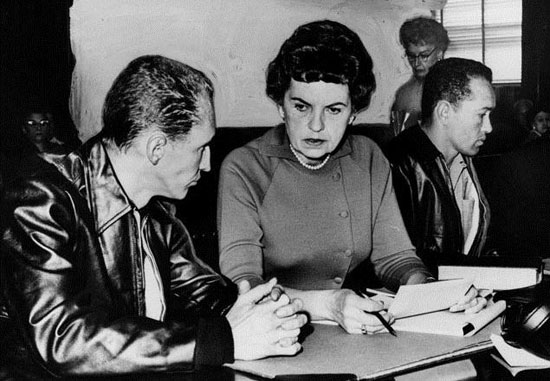
In this 1963 photo, Public Defender Kathryn McDonald confers with client Gregory Powell (left), who was accused with Jimmy Lee Smith in the "Onion Field" killing of LAPD officer Ian Cambell.
In the early 1880s, an Italian immigrant in San Francisco was charged with trying to collect $500 in insurance by torching his house on Telegraph Hill. The man was innocent but could not afford a decent attorney, and when his trial date rolled around, his lawyer didn’t show.
So the judge, as judges did then, went into the hallway and ordered the first lawyer he saw to represent the defendant. This didn’t bode well, since most court-appointed defense lawyers at the time were not only unpaid but also incompetent.
The lawyer—Clara Shortridge Foltz—was, in fact, just out of law school. But she won the case and used it as Exhibit A in a national push that led to the opening of the nation’s first public defender’s office in 1914 in Los Angeles.
One hundred years later, the Public Defender’s Office of Los Angeles County is marking its centennial anniversary. Some 700 attorneys work there now—more than at any criminal defense firm in the nation—along with hundreds of investigators, paralegals, psychiatric social workers and support staff. Last fiscal year, they defended clients in more than 400,000 felony and misdemeanor cases, not counting the thousands more defendants in juvenile delinquency and mental health courts.
Like Foltz, they occasionally make history. And, like Foltz, they tend not to become particularly famous. (In 2001, when the criminal courthouse downtown was renamed in her honor, the Los Angeles Times noted “a chorus of people saying: ‘Clara Who?’”)
“We usually pick up cases because nobody else is there,” says Alan Simon, a now-retired public defender bureau chief who spent five mostly unsung years representing the Hillside Strangler, Kenneth Bianchi.
“But most of the great names in public defense are not the ones that you see in the headlines. Charlie Gessler was probably one of the best defense lawyers ever. Do you know who he is? Probably not.”

Deputy Public Defenders Bernadette Everman and Dave Meyer at arraignment of "Night Stalker" Richard Ramirez.
Less obscure are some of the names of the clients represented over the years by the department. The Night Stalker had a public defender. So did the Onion Field killers and members of the Manson and Menendez families. Public defenders played a key role in uncovering the Rampart scandal at LAPD in the 1990s, and handled the crush of cases filed in the wake of both the Watts Riots and the L.A. Riots.
Most of the office’s clients, however, are the kinds of people to whom society tends to pay little attention—the impoverished, the downtrodden, the lost, the addicted, the difficult.
“It’s a calling,” says Public Defender Ron Brown, who has spent 33 years in the office, where turnover for reasons other than retirement averages a miniscule 2 percent a year.
“Our clients aren’t always nice people,” Brown says. “But somebody has to defend them, and vigorously defend them, in order for justice to be done. So what we do is about protecting peoples’ constitutional rights, and people who work here find that this is a place where they can do God’s work, as corny as that may sound.”
As integral as the Public Defender’s Office now is to the legal system, it was a radical notion when it began. It arose from decades of lobbying by Foltz, whose long list of accomplishments included being the first female lawyer in California. With fellow suffragettes and Progressive allies, she sought to balance the odds in the late 1800s against impoverished defendants who were often railroaded by ambitious prosecutors and judges, even though they were supposed to be presumed innocent.
At the time, the state prosecuted people suspected of criminal wrongdoing, but didn’t underwrite any of their defense costs. A judge could appoint a lawyer to represent a pauper. But the court-appointed attorney, who was duty-bound to take the assignment, had to work without pay, or pro bono.
As a result, few competent lawyers made themselves available for such work. Instead, judges typically drew from the lowest ranks of the courthouse pecking order, often strolling out into the hallways and grabbing whoever happened to be around.
Foltz was outraged by the situation. A lawyer’s daughter, she had turned to the law to support herself after her husband deserted her and their five children. She had a soft spot for the poor.
She also had a knack for agitation: When she learned that only white males could become lawyers in California, she hounded the governor into signing landmark legislation to abolish the inequality. When she couldn’t’ get into law school, she sued for admission. Now, pressed into action on behalf of poor clients, she believed the time had come for lawyers like her to be able to make a living.
So she began agitating for legal reforms that would guarantee a paid defense and balance the odds against the defendant. According to a definitive biography of Foltz by retired Stanford law professor Barbara Babcock, she spent three decades campaigning in state legislatures and drafting model statutes before a political tide of Progressives and women—who had just gotten the vote here—led to success in California.
By then, Foltz was working as a deputy district attorney in Los Angeles County, another first for a woman, and was an influential political voice, both nationally and here. In November 1912, Los Angeles County voters approved a charter that included the creation of the Office of the Public Defender, and the following year, it was ratified by the state legislature.
After a competitive exam, the Board of Supervisors appointed Walton J. Wood, a Los Angeles deputy city attorney, as the first public defender in the nation. The office opened on Jan. 9, 1914.
Over the years, according to Public Defender Brown, the office’s focus has changed with the societal landscape.
“In the past, we looked exclusively at winning—at getting the guy out and moving on,” he says. “The thought was that we’re lawyers, not social workers. But in fact, a good lawyer really is a kind of social worker. You end up getting involved with everything from housing to mental health needs.”
To that end, the office now works closely with social services in the county, from children’s services to mental health. It also has helped pioneer the use of specialized courts for addicts, veterans, the mentally ill and women, and has become involved in communities with programs like Parks After Dark.
And as it heads into its next century, he says, the department has added to its diversity in ways that would probably please the suffragette who made it happen: More than half of the lawyers—from trial lawyers to managers—are female now.
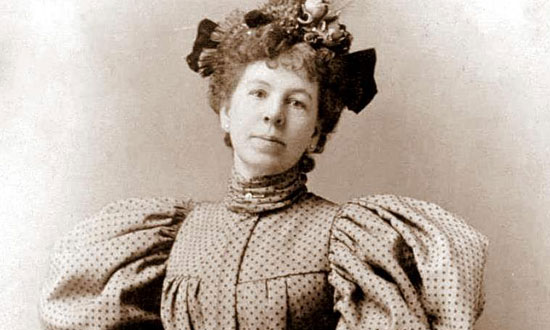
Clara Shortridge Foltz's groundbreaking activism led to the creation of L.A. County's Public Defender's Office in 1914, the first of its kind in the nation.
Posted 2/21/14
Making spirits bright
December 6, 2013
The holiday season demands a soundtrack, and for many musicians, this is one of the busiest times of the year.
Just ask Jane Sarture what her ensemble is up to these days.
“We played this morning in a real estate office,” Sarture said. “We’re going to go out to hospitals, senior centers, the Ronald McDonald House charity Christmas party. We’ll be playing at Olive View hospital. We’re going to be at the Kaiser farmer’s market… I don’t think I ever stopped to count yet but I think we have 25 performances across 24 days.”
Sarture is a music director, but she’s not leading a local orchestra, singing group or jazz combo. Her musicians are developmentally disabled adults who play in the ARC Handbell Choir.
Their rendition of “Jingle Bells” may not be the slickest version you’ll hear this season, but it’s undoubtedly the most heartwarming.
“It is inspiring,” said Sarture, 52, a former associate producer of television game shows who switched careers to work at ARC 22 years ago and now accompanies the group on keyboard during their performances.
“The first day I walked in, I was like, “This is so cool.’ It’s like that old cliché: it’s not a job, it’s a calling,” she said of her work at the non-profit ARC (Activities Recreation and Care). The North Hollywood organization offers adults with cognitive disabilities a chance to take part in a wide range of life-enriching activities, from camping and field trips to volunteering at senior centers and even running marathons. The handbell choir is one of the most visible manifestations of the organization’s mission; they’ve performed 11 times since 1999 in the county’s Holiday Celebration, which is broadcast live on KCET. (This video captures one of their previous performances.)
This year, they’re returning to the stage of the Dorothy Chandler Pavilion for the 12th time to perform in the annual Christmas Eve extravaganza, produced by the county Arts Commission and featuring an array of performers in many genres. If past experience is any indication, look for the audience to respond to the handbell choir with a rousing ovation—and perhaps a discreet tear or two.
“People are amazed,” said Jennifer Davis, an ARC employee who conducts the ensemble’s performances and also serves as the organization’s volunteer marathon coach. She ran the New York Marathon this year with ARC client Jimmy Jenson, who has Down syndrome and received national acclaim on the “Today” show for his accomplishment.
“A lot of times people see the young, cute babies and they don’t know what happens [to the developmental disabled] when they grow up,” Davis said. “You’ll see people with tears streaming down their faces and they’ll say ‘I have a six-year-old and to think that my child can grow up and live such a phenomenal life.’ ”
Davis said an overarching message behind the group’s success is a determination to look past what people can’t do and focus instead on what each individual is capable of.
“When we look at what we can do, and what we can contribute, that’s when community and the real music in life happens,” she said.
ARC’s handbell choir has been jingling all the way since 1985 and now performs year-round.
They don’t charge for their performances, but happily accept donations, which Sarture said can range from “a great lunch and a couple of candy canes” to a check for $50 or even $2,000.
It all comes in handy when you’re trying run a handbell choir.
“It’s an expensive operation,” Sarture said. “If you drop a bell, it’s $200.”
There’s plenty of music in the air, but one thing you won’t hear from this group is any complaining about how busy things get when the holidays roll around.
“It’s amazing,” said one performer, 34-year-old Hillary Shaw, after an evening performance at a holiday open house in Supervisor Zev Yaroslavsky’s Van Nuys district office this week.
And as for Sarture? “It’s a blast,” she said. “It’s my favorite time of the year.”
Posted 12/6/13
Kitty cat 90210
October 24, 2013
Even a cat can dream big in this town. Take Harry. Just five months ago, he was wandering the alleys. Now he lives in a landmark 6.5-acre Beverly Hills estate.
At the Virginia Robinson Gardens, a 102-year-old historic property owned by Los Angeles County, staffers say the white stray with the black tail and ear has been an unofficial colleague since April.
“He just showed up one day and started following one of the gardeners around,” said Superintendent Timothy Lindsay on a recent morning. “He was very friendly, very domesticated—and very vocal.”
“Meoooow,” confirmed Harry, glancing up from the tiled Italianate pool, where he appeared to be alternately drinking and scouring the blue water for signs of sea life.
“He likes to think there are fish in there,” whispered Lindsay.
Harry switched his tail. Lindsay said he was recently named Chief Mouser and Rat Patrol.
The property, built by the heir to the Robinson’s Department Store fortune and bequeathed to the county after his widow’s death in 1977, is a paradise, even by non-cat standards. A national, state and local landmark, it is now operated by the county Department of Parks and Recreation and supported by the nonprofit Friends of Robinson Gardens as one of Los Angeles County’s first great estates.
The owners, Harry and Virginia Robinson, were community pillars in L.A. for decades, famed for their star-studded parties, their elaborate landscaping and the many pets on whom they lavished attention.
“I think they were more dog people,” Lindsay said, noting the canine paw prints in the concrete walks connecting the estate’s five gardens. “And they had 300 blue songbirds that she imported from New Zealand, and a toucan that spent time on the loggia, eavesdropping on all the Hollywood gossip.”
But Lindsay said the cat, who sauntered in without even a microchip of identification, had such a confident air that the gardens staff named him after the estate’s founder. After a student working on the grounds volunteered to take him to the veterinarian to make sure he was vaccinated against rabies, the staff and live-in groundskeeper took him in and started to feed him.
“He’s a great mouser, and averages two a day,” says Lindsay. “He brings them to the kitchen door and drops them. And he’s so entertaining—he flops over like a dog and wants you to rub his belly. He sleeps in the laundry room in the staff quarters adjacent to the main house. We have a little bed for him.”
Harry isn’t the only creature to have adopted the gardens, says Lindsay. Coyotes drop in occasionally, and two horned owls have taken up residence in the estate’s King Palm grove. But, he says, the cat is the estate’s only domestic pet.
“He’s made this his house,” Lindsay said as Harry trotted across the flossy emerald lawn, settling in for a nap near the Renaissance Revival pool pavilion, which was modeled after Italy’s famed Villa Pisani. “The cat’s no dummy. He picked the nicest place in the neighborhood.”
Posted 10/24/13
Carbs gone wild at the fair
September 5, 2013
It was 100 degrees at the Los Angeles County Fair in Pomona, but at Chicken Charlie’s food stand, Nelly Alvarez was hustling to keep up with demand for this year’s signature dish.
“Yep, it’s a half-pound double cheeseburger between two Krispy Kreme donuts—really,” Alvarez explained to one wide-eyed taker after another. “I hear they’re pretty good!”
Privately, however, Alvarez confessed that she actually hasn’t tried Chicken Charlie’s cheesy, meaty, sugary, gooey new 1,160-calorie item, which this week joined the fair vendor’s menu of deep-fried avocados, deep-fried pickles, deep-fried Oreos, deep-fried Kool-Aid, Krispy Kreme Sloppy Joes and other diet-busting fare. After seven years working at fair booths, she said, she now brown-bags it at her lunch breaks.
“I bring a lot of fruit, a lot of water,” she laughed, looking around to make sure no potential customers were listening. “I brought a salad today.”
Few displays evoke more mixed feelings in food- and health-obsessed Southern California than the deep-fried gluttony of the Los Angeles County Fair. In L.A., where food trucks compete with high-end juice bars, and bacon-wrapped everything vies with the pursuit of the perfect kale salad, the fair menu never fails to offer an over-the-top serving of amusement, rebellion and carbs gone wild.
“I try to be good. I try!” said Marie Thomas of Carson, wandering through a haze of Texas barbecue smoke, kettle corn and cotton candy. “But once a year? C’mon.”
After all, she pointed out, she shopped hard at the fair, which theoretically might burn off some extra calories. “So right now, I’m looking for something cheesy, something greasy and something fried.”
Los Angeles County Director of Public Health Dr. Jonathan E. Fielding, whose department has been part of a nationwide anti-obesity effort, says there’s nothing wrong with the occasional splurge. Everything in moderation—that’s essentially the theme of the county’s Choose Less, Weigh Less campaign.
“I can’t say not to go to the fair,” Fielding says, noting that he rarely misses. In fact, he said, his department plans to staff a booth there for County Day later this week.
“But I’m in favor of choice, and sometimes the choice at the fair isn’t as broad as it is in other places.” Indeed, asked how to eat at the fair and remain healthy, Fielding was hard-pressed: “Well,” he joked, “I think at one point I saw corn.”
Fair spokeswoman Renee Hernandez says some healthy food does, in fact, co-exist with the traditional extreme fair food.
“Cardinale’s Wood Fired Pizza has a pizza salad, which is a bed of romaine and mixed greens with healthy pizza toppings,” she says. “And there are chicken and shrimp kebabs.”
And, she notes, there’s Terri’s Berries, the Encinitas-based fruit stand that has been at the fair for decades.
“We get a lot of people who are happy to find us,” said Elodie Crutchfield, proffering whole fruit and baskets of berries, some of which were, shockingly, not even dipped in chocolate. “I know the ceviche stand has a mango cup, but that’s the only other healthy fruit option I know of here.”
DPH Director Fielding noted that eating something nutritious before or after a trip to the fair might work for some people. “I think you just have to choose carefully and not be easily seduced by what looks most appetizing on an empty stomach.”
But sometimes the pull is just too overwhelming.
“This looks amazing!” cried 13-year-old Daniel Chinn as donut glaze oozed onto the bright yellow cheese of his Krispy Kreme burger.
Afterward, the youngster was less enthusiastic.
“It was good,” he said, slumped at the lunch table and wearing a wan expression. “But now I feel horrible.”
Posted 9/5/13




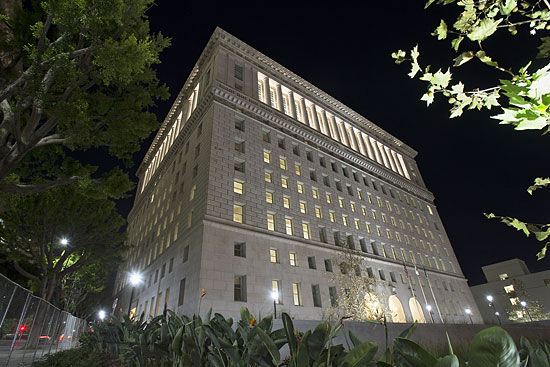
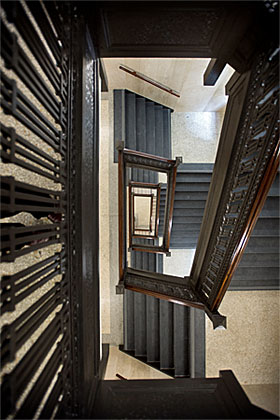
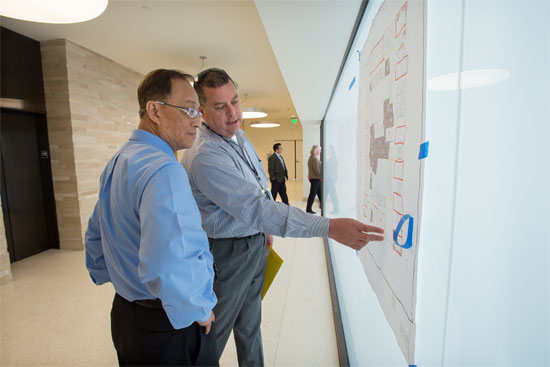
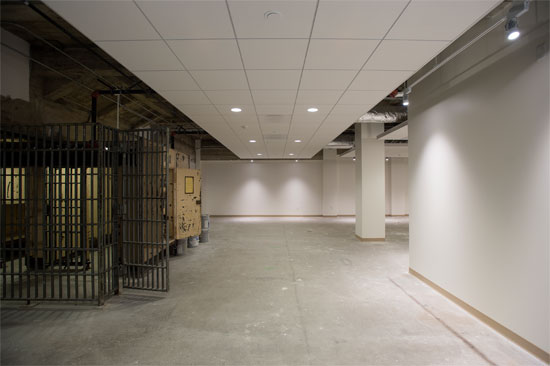
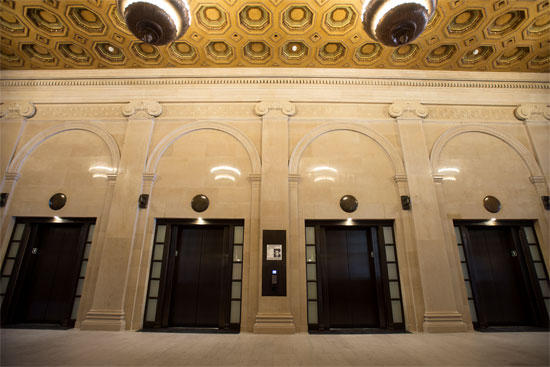
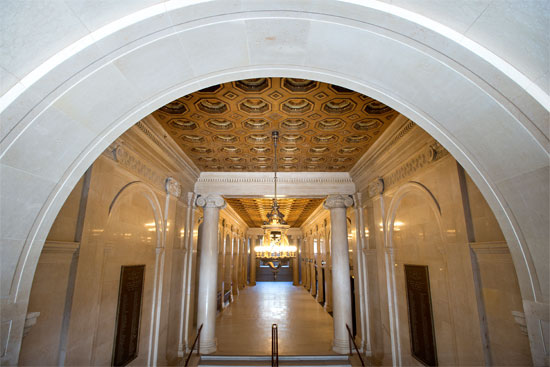
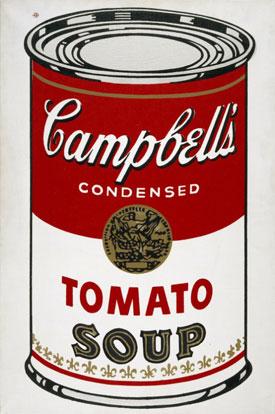
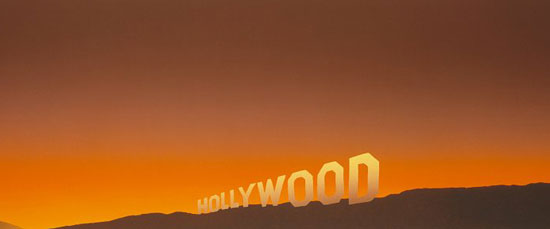
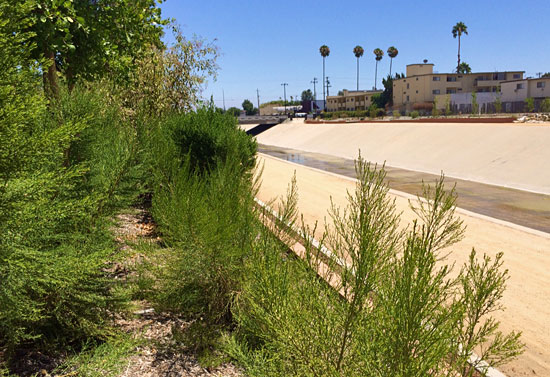
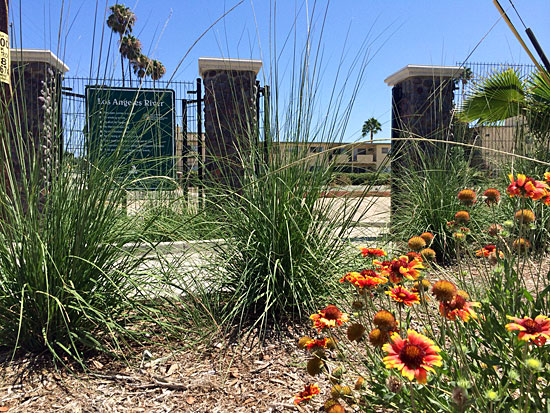


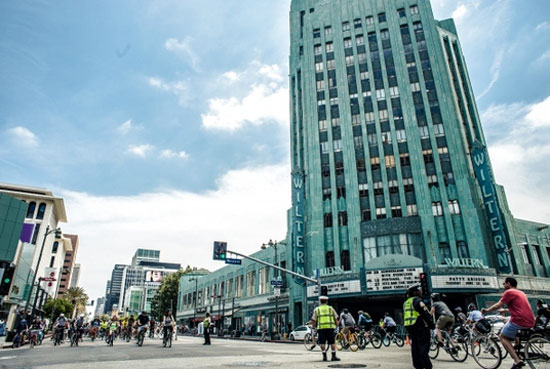
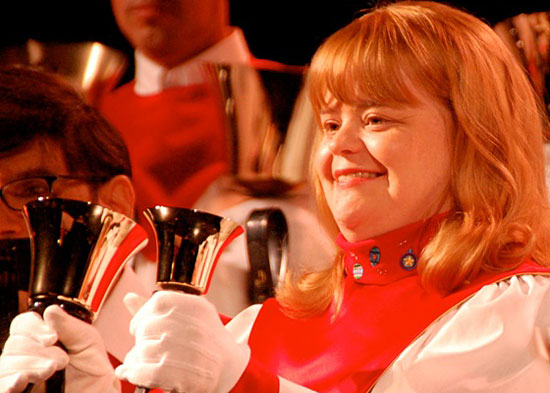

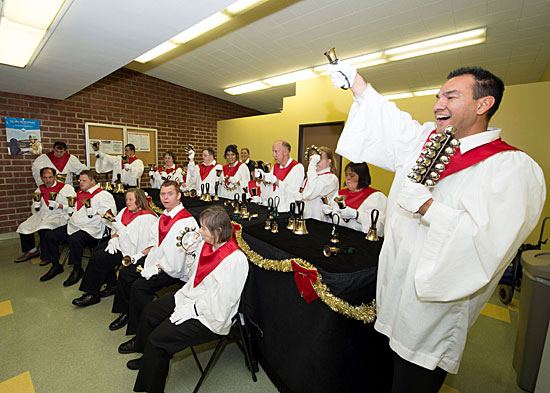
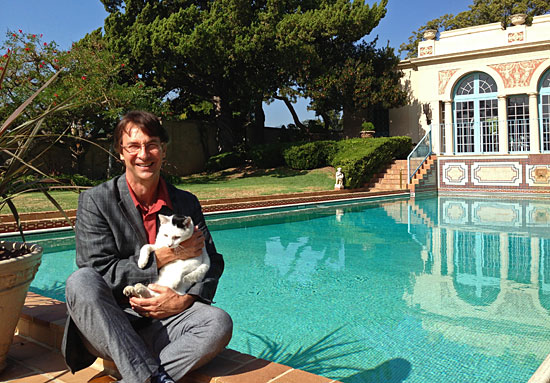
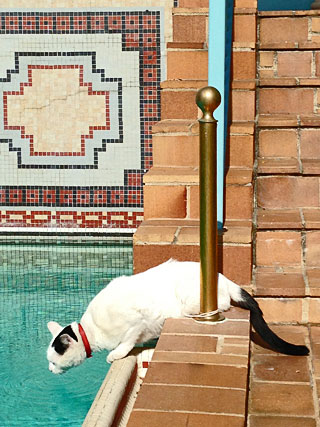
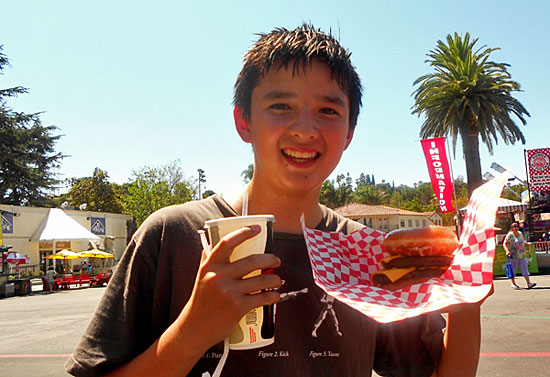
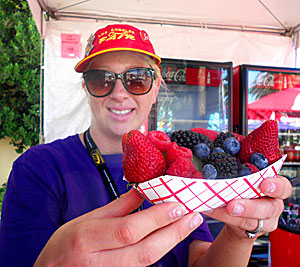
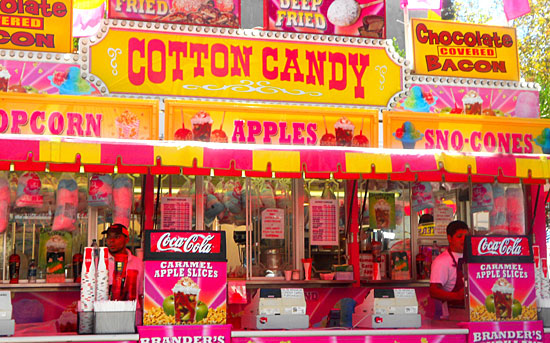







 405 bridge work causes a stink
405 bridge work causes a stink

